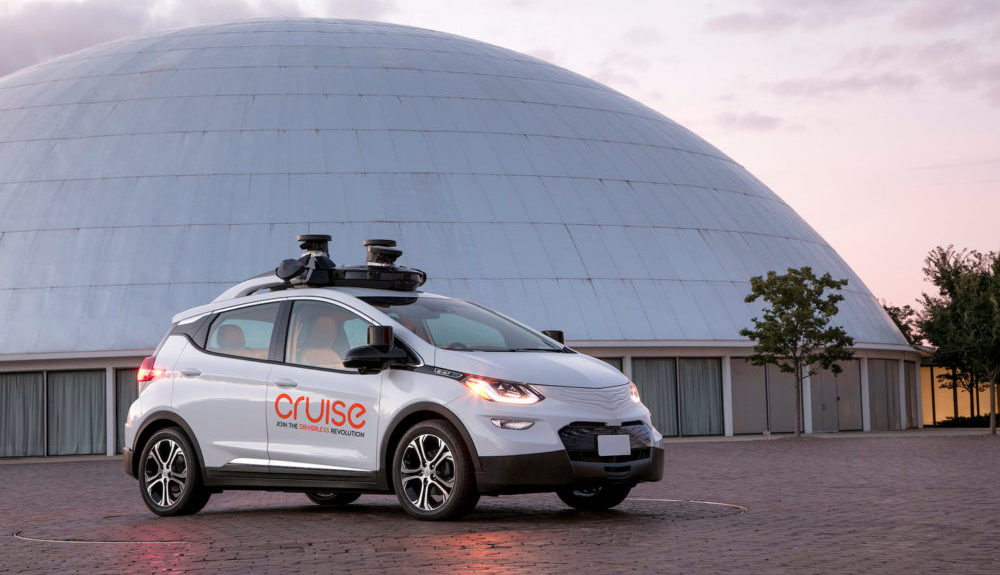
An autonomous, all-electric Chevrolet Bolt from Cruise, which raised $1.15 billion in May 2019. | Credit: Cruise
Robotics companies raised more than $15.6 billion during the first half of 2019. According to the robotics investments tracked and verified by The Robot Report, more than $2.6 billion was raised on average per month. The year started slowly with $644 million raised in January, but there was at least $1.3 billion raised each month thereafter.
For The Robot Report‘s investment analysis, autonomous vehicles, including technologies that support autonomous driving, and drones are considered robots. On the other hand, 3D printers, CNC systems, and various types of “hard” automation are not.
Robotics Investments for First 6 Months of 2019
| Month | Investment Amount |
|---|---|
| January | $644M |
| February | $4.3B |
| March | $1.3B |
| April | $6.5B |
| May | $1.5B |
| June | $1.4B |
| Yearly Total | $15.64B |
As you can see in the table below, autonomous vehicle investments made up a significant percentage of overall funding. Ten of the top 20 robotics investments tracked by The Robot Report belonged to companies producing autonomous vehicles or autonomous vehicle enabling technologies. Autonomous vehicle companies raised 55% ($4.6 billion) of the total $8.2 billion raised in the 20 investments. The top three autonomous vehicle investments belonged to Cruise ($1.15 billion), Uber ($1 billion) and Nuro ($940 million), which raised a combined $3.1 billion.
Healthcare robotics companies have also fared well in 2019. Intuitive Surgical raised $2 billion via a stock repurchase in February, while Think Surgical and Ekso Bionics raised $134 million and $100 million, respectively. HistoSonics raised $54 million in April for its medical robotics platform that destroy cancerous tumors without affecting surrounding tissue.
The Robot Report will have a detailed breakdown of investments by sector in a follow-up article.
To stay updated about the latest robotics investments and acquisitions, check out The Robot Report‘s Investment Section.
20 Largest Robotics Investments During 1st Half of 2019
| Company | Funding (M$) | Lead Investor | Date | Technology |
|---|---|---|---|---|
| Intuitive Surgical | 2000 | Stock Repurchase | 2/1/19 | Surgical Robots |
| Cruise | 1150 | Honda Motor Corp. | 5/7/19 | Autonomous Vehicles |
| Uber ATG | 1000 | SoftBank Vision Fund | 4/18/19 | Autonomous Vehicles |
| Nuro.ai | 940 | SoftBank Vision Fund | 2/11/19 | Autonomous Vehicles |
| Horizon Robotics | 600 | SK China | 2/27/19 | AI/IOT |
| Aurora Innovation | 600 | Amazon | 2/7/19 | Autonomous Vehicles |
| Weltmeister Motor | 450 | Baidu Inc. | 3/11/19 | Autonomous Vehicles |
| Cloudminds | 300 | SoftBank Vision Fund | 3/26/19 | Service Robots |
| Zipline | 190 | TPG | 5/17/19 | Drone Delivery |
| Innoviz Technologies | 170 | China Merchants Capital | 3/26/19 | LiDAR |
| Think Surgical | 134 | 3/11/19 | Surgical Robots | |
| Beijing Auto AI Technology | 104 | Robert Bosch Venture Capital | 1/24/19 | AI |
| Black Sesame Technologies | 100 | Legend Capital | 4/15/2019 | Machine Learning |
| Ekso Bionics Holdings | 100 | Zhejiang Youchuang Venture Capital Investment Co. | 1/30/19 | Exoskeletons |
| TUSimple | 95 | Sina Corp | 2/13/19 | Autonomous Vehicles |
| Ouster | 60 | Runway Growth Capital | 3/25/19 | LiDAR |
| NASN Automotive | 59.6 | Matrix Partners China | 1/30/19 | Autonomous Vehicles |
| HistoSonics | 54 | Varian Medical | 4/8/19 | Medical Robots |
| Ike | 52 | Bain Capital Ventures | 2/5/19 | Autonomous Vehicles |
| Enflame | 43.4 | Redpoint China Ventures | 6/6/2019 | AI Chipmaker |
Editors note: What defines robotics investments? The answer to this simple question is central in any attempt to quantify robotics investments with some degree of rigor. To make investment analyses consistent, repeatable, and valuable, it is critical to wring out as much subjectivity as possible during the evaluation process. This begins with a definition of terms and a description of assumptions.
Investors and investing
Investment should come from venture capital firms, corporate investment groups, angel investors, and other sources. Friends-and-family investments, government/non-governmental agency grants, and crowd-sourced funding are excluded.
Robotics and intelligent systems companies
Robotics companies must generate or expect to generate revenue from the production of robotics products (that sense, think, and act in the physical world), hardware or software subsystems and enabling technologies for robots, or services supporting robotics devices. For this analysis, autonomous vehicles (including technologies that support autonomous driving) and drones are considered robots, while 3D printers, CNC systems, and various types of “hard” automation are not.
Companies that are “robotic” in name only, or use the term “robot” to describe products and services that that do not enable or support devices acting in the physical world, are excluded. For example, this includes “software robots” and robotic process automation. Many firms have multiple locations in different countries. Company locations given in the analysis are based on the publicly listed headquarters in legal documents, press releases, etc.
Verification
Funding information is collected from a number of public and private sources. These include press releases from corporations and investment groups, corporate briefings, and association and industry publications. In addition, information comes from sessions at conferences and seminars, as well as during private interviews with industry representatives, investors, and others. Unverifiable investments are excluded.
The post 20 largest robotics investments during 1st half of 2019 appeared first on The Robot Report.
阅读原文